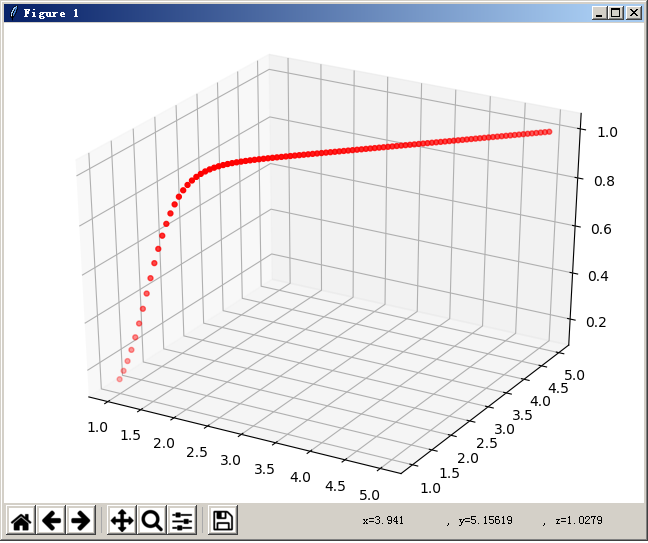class 二分类Demo { public static void Demo() { List<float[]> inputs_x = new List<float[]>(); inputs_x.Add(new float[] { 0.9f, 0.6f }); inputs_x.Add(new float[] { 2f, 2.5f }); inputs_x.Add(new float[] { 2.6f, 2.3f }); inputs_x.Add(new float[] { 2.7f, 1.9f }); List<float> inputs_y = new List<float>(); inputs_y.Add(0); inputs_y.Add(1); inputs_y.Add(1); inputs_y.Add(1); float[] weights = new float[inputs_x.First().Length+1];//加上b for (var i = 0; i < weights.Length; i++) weights[i] = (float)new Random().NextDouble(); int epoch = 30000; float epsilon = 0.00000000000000001f; float lr = 0.01f; float lastCost = 0; for (var epoch_i = 0; epoch_i <= epoch; epoch_i++) { //随机获取input var batch = GetRandomBatch(inputs_x, inputs_y, 2); float[] weights_in_poch = new float[weights.Length]; foreach (var x_y in batch) { var x1 = x_y.Item1.First(); var x2 = x_y.Item1.Skip(1).Take(1).First(); var target_y = x_y.Item2; float diffWithTargetY = target_y - Sigmoid(fun(x1, x2, weights[1], weights[2], weights[0])); weights_in_poch[0] += diffWithTargetY * dy_b(x1, x2); weights_in_poch[1] += diffWithTargetY * dy_theta1(x1, x2); weights_in_poch[2] += diffWithTargetY * dy_theta2(x1, x2); } for (var i = 0; i < weights.Length; i++) weights[i] += lr * weights_in_poch[i]; float totalErrorCost = 0f; foreach (var x_y in batch) { var x1 = x_y.Item1.First(); var x2 = x_y.Item1.Skip(1).Take(1).First(); var target_y = x_y.Item2; float diffWithTargetY = target_y - Sigmoid(fun(x1, x2, weights[1], weights[2], weights[0])); totalErrorCost += (float)System.Math.Pow(diffWithTargetY, 2) / 2; } float cost = totalErrorCost / batch.Count; if (System.Math.Abs(cost - lastCost) <= epsilon) { Console.WriteLine(string.Format("EPOCH {0}", epoch_i)); Console.WriteLine(string.Format("LAST MSE {0}", lastCost)); Console.WriteLine(string.Format("MSE {0}", cost)); break; } lastCost = cost; if (epoch_i % 100 == 0 || epoch_i == epoch) { Console.WriteLine(string.Format("MSE {0}", cost)); } } print(weights[1], weights[2], weights[0]); Console.ReadLine(); } private static List<Tuple<float[], float>> GetRandomBatch(List<float[]> inputs_x, List<float> inputs_y, int maxCount) { List<Tuple<float[], float>> lst = new List<Tuple<float[], float>>(); System.Random rnd = new Random((int)DateTime.Now.Ticks); int count = 0; while (count < maxCount) { int rndIndex = rnd.Next(inputs_x.Count); var item = Tuple.Create<float[], float>(inputs_x[rndIndex], inputs_y[rndIndex]); lst.Add(item); count++; } return lst; } private static void print(float theta1, float theta2, float b) { Console.WriteLine(string.Format("y=sigmoid({0}*x1+{1}*x2+{2})", theta1, theta2, b)); } private static float Sigmoid(double x) { double one = 1; var result= one / (one + System.Math.Exp(-x)); return (float)result; } private static float fun(float x1, float x2, float theta1, float theta2, float b) { return theta1 * x1 + theta2 * x2 + b; } private static float dy_theta1(float x1, float x2) { return x1; } private static float dy_theta2(float x1, float x2) { return x2; } private static float dy_b(float x1, float x2) { return 1; } }
import matplotlib.pyplot as plt import numpy as np x1=np.array([0.9,2,2.6,2.7], dtype=np.float) x2=np.array([0.6,2.5,2.3,1.9], dtype=np.float) def sigmoid(v): return 1/ (1 + np.exp(-v)) #y=sigmoid(0.8277054*x1+0.893053*x2+-0.7201675) #y=sigmoid(1.968242*x1+4.206787*x2+-7.930489) def y_function(x1, x2): #return sigmoid(0.8277054*x1+0.893053*x2-0.7201675) return sigmoid(1.968242*x1+4.206787*x2-7.930489) y=y_function(x1, x2) for index, y_value in enumerate(y): if(y_value>0.5): plt.scatter([x1[index]], [x2[index]], c = 'red',marker = 'o') else: plt.scatter([x1[index]], [x2[index]], c = 'blue',marker = 'o') plt.show()

3D图形:
import matplotlib.pyplot as plt import numpy as np from mpl_toolkits.mplot3d import Axes3D def sigmoid(v): return 1/ (1 + np.exp(-v)) x1=np.linspace(1, 5, 100) x2=np.linspace(1, 5, 100) y=1.968242*x1+4.206787*x2-7.930489 y_s=sigmoid(y) fig = plt.figure() ax = Axes3D(fig) ax.scatter(x1, x2, y_s, c='r', marker='.', s=50, label='') plt.show()
